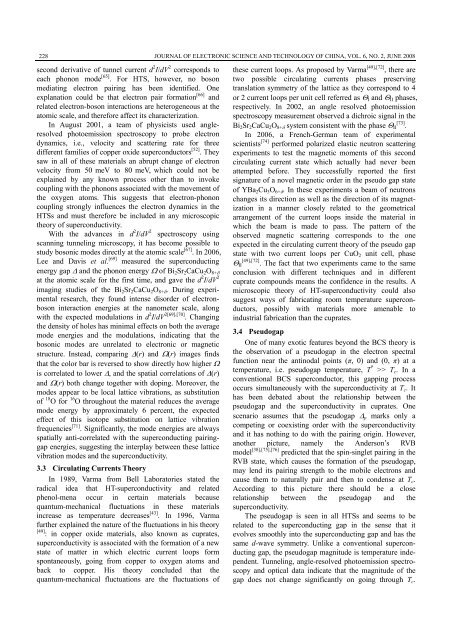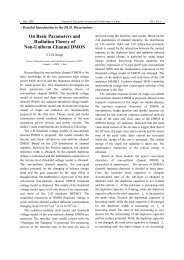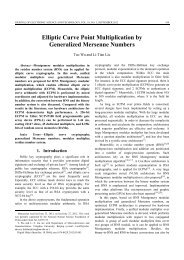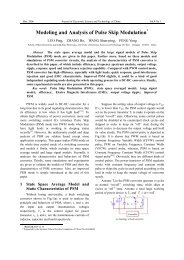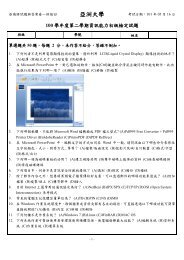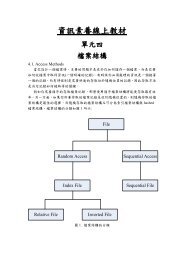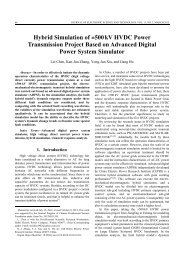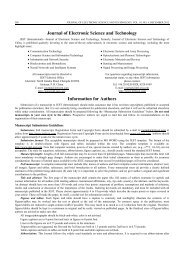High Temperature Superconductivity in the Past Twenty Years Part 1 ...
High Temperature Superconductivity in the Past Twenty Years Part 1 ...
High Temperature Superconductivity in the Past Twenty Years Part 1 ...
You also want an ePaper? Increase the reach of your titles
YUMPU automatically turns print PDFs into web optimized ePapers that Google loves.
228second derivative of tunnel current d 2 I/dV 2 corresponds toeach phonon mode [65] . For HTS, however, no bosonmediat<strong>in</strong>g electron pair<strong>in</strong>g has been identified. Oneexplanation could be that electron pair formation [66] andrelated electron-boson <strong>in</strong>teractions are heterogeneous at <strong>the</strong>atomic scale, and <strong>the</strong>refore affect its characterization.In August 2001, a team of physicists used angleresolvedphotoemission spectroscopy to probe electrondynamics, i.e., velocity and scatter<strong>in</strong>g rate for threedifferent families of copper oxide superconductors [52] . Theysaw <strong>in</strong> all of <strong>the</strong>se materials an abrupt change of electronvelocity from 50 meV to 80 meV, which could not beexpla<strong>in</strong>ed by any known process o<strong>the</strong>r than to <strong>in</strong>vokecoupl<strong>in</strong>g with <strong>the</strong> phonons associated with <strong>the</strong> movement of<strong>the</strong> oxygen atoms. This suggests that electron-phononcoupl<strong>in</strong>g strongly <strong>in</strong>fluences <strong>the</strong> electron dynamics <strong>in</strong> <strong>the</strong>HTSs and must <strong>the</strong>refore be <strong>in</strong>cluded <strong>in</strong> any microscopic<strong>the</strong>ory of superconductivity.With <strong>the</strong> advances <strong>in</strong> d 2 I/dV 2 spectroscopy us<strong>in</strong>gscann<strong>in</strong>g tunnel<strong>in</strong>g microscopy, it has become possible tostudy bosonic modes directly at <strong>the</strong> atomic scale [67] . In 2006,Lee and Davis et al. [69] measured <strong>the</strong> superconduct<strong>in</strong>genergy gap Δ and <strong>the</strong> phonon energy Ω of Bi 2 Sr 2 CaCu 2 O 8+δat <strong>the</strong> atomic scale for <strong>the</strong> first time, and gave <strong>the</strong> d 2 I/dV 2imag<strong>in</strong>g studies of <strong>the</strong> Bi 2 Sr 2 CaCu 2 O 8+δ . Dur<strong>in</strong>g experimentalresearch, <strong>the</strong>y found <strong>in</strong>tense disorder of electronboson<strong>in</strong>teraction energies at <strong>the</strong> nanometer scale, alongwith <strong>the</strong> expected modulations <strong>in</strong> d 2 I/dV 2[69],[70] . Chang<strong>in</strong>g<strong>the</strong> density of holes has m<strong>in</strong>imal effects on both <strong>the</strong> averagemode energies and <strong>the</strong> modulations, <strong>in</strong>dicat<strong>in</strong>g that <strong>the</strong>bosonic modes are unrelated to electronic or magneticstructure. Instead, compar<strong>in</strong>g Δ(r) and Ω(r) images f<strong>in</strong>dsthat <strong>the</strong> color bar is reversed to show directly how higher Ωis correlated to lower Δ, and <strong>the</strong> spatial correlations of Δ(r)and Ω(r) both change toge<strong>the</strong>r with dop<strong>in</strong>g. Moreover, <strong>the</strong>modes appear to be local lattice vibrations, as substitutionof 18 O for 16 O throughout <strong>the</strong> material reduces <strong>the</strong> averagemode energy by approximately 6 percent, <strong>the</strong> expectedeffect of this isotope substitution on lattice vibrationfrequencies [71] . Significantly, <strong>the</strong> mode energies are alwaysspatially anti-correlated with <strong>the</strong> superconduct<strong>in</strong>g pair<strong>in</strong>ggapenergies, suggest<strong>in</strong>g <strong>the</strong> <strong>in</strong>terplay between <strong>the</strong>se latticevibration modes and <strong>the</strong> superconductivity.3.3 Circulat<strong>in</strong>g Currents TheoryIn 1989, Varma from Bell Laboratories stated <strong>the</strong>radical idea that HT-superconductivity and relatedphenol-mena occur <strong>in</strong> certa<strong>in</strong> materials becausequantum-mechanical fluctuations <strong>in</strong> <strong>the</strong>se materials<strong>in</strong>crease as temperature decreases [43] . In 1996, Varmafur<strong>the</strong>r expla<strong>in</strong>ed <strong>the</strong> nature of <strong>the</strong> fluctuations <strong>in</strong> his <strong>the</strong>ory[49] : <strong>in</strong> copper oxide materials, also known as cuprates,superconductivity is associated with <strong>the</strong> formation of a newstate of matter <strong>in</strong> which electric current loops formspontaneously, go<strong>in</strong>g from copper to oxygen atoms andback to copper. His <strong>the</strong>ory concluded that <strong>the</strong>quantum-mechanical fluctuations are <strong>the</strong> fluctuations ofJOURNAL OF ELECTRONIC SCIENCE AND TECHNOLOGY OF CHINA, VOL. 6, NO. 2, JUNE 2008<strong>the</strong>se current loops. As proposed by Varma [49],[72] , <strong>the</strong>re aretwo possible circulat<strong>in</strong>g currents phases preserv<strong>in</strong>gtranslation symmetry of <strong>the</strong> lattice as <strong>the</strong>y correspond to 4or 2 current loops per unit cell referred as Θ I and Θ II phases,respectively. In 2002, an angle resolved photoemissionspectroscopy measurement observed a dichroic signal <strong>in</strong> <strong>the</strong>Bi 2 Sr 2 CaCu 2 O 8+δ system consistent with <strong>the</strong> phase Θ II [73] .In 2006, a French-German team of experimentalscientists [74] performed polarized elastic neutron scatter<strong>in</strong>gexperiments to test <strong>the</strong> magnetic moments of this secondcirculat<strong>in</strong>g current state which actually had never beenattempted before. They successfully reported <strong>the</strong> firstsignature of a novel magnetic order <strong>in</strong> <strong>the</strong> pseudo gap stateof YBa 2 Cu 3 O 6+δ . In <strong>the</strong>se experiments a beam of neutronschanges its direction as well as <strong>the</strong> direction of its magnetization<strong>in</strong> a manner closely related to <strong>the</strong> geometricalarrangement of <strong>the</strong> current loops <strong>in</strong>side <strong>the</strong> material <strong>in</strong>which <strong>the</strong> beam is made to pass. The pattern of <strong>the</strong>observed magnetic scatter<strong>in</strong>g corresponds to <strong>the</strong> oneexpected <strong>in</strong> <strong>the</strong> circulat<strong>in</strong>g current <strong>the</strong>ory of <strong>the</strong> pseudo gapstate with two current loops per CuO 2 unit cell, phaseΘ II [49],[72] . The fact that two experiments came to <strong>the</strong> sameconclusion with different techniques and <strong>in</strong> differentcuprate compounds means <strong>the</strong> confidence <strong>in</strong> <strong>the</strong> results. Amicroscopic <strong>the</strong>ory of HT-superconductivity could alsosuggest ways of fabricat<strong>in</strong>g room temperature superconductors,possibly with materials more amenable to<strong>in</strong>dustrial fabrication than <strong>the</strong> cuprates.3.4 PseudogapOne of many exotic features beyond <strong>the</strong> BCS <strong>the</strong>ory is<strong>the</strong> observation of a pseudogap <strong>in</strong> <strong>the</strong> electron spectralfunction near <strong>the</strong> ant<strong>in</strong>odal po<strong>in</strong>ts (π, 0) and (0, π) at atemperature, i.e. pseudogap temperature, T * >> T c . In aconventional BCS superconductor, this gapp<strong>in</strong>g processoccurs simultaneously with <strong>the</strong> superconductivity at T c . Ithas been debated about <strong>the</strong> relationship between <strong>the</strong>pseudogap and <strong>the</strong> superconductivity <strong>in</strong> cuprates. Onescenario assumes that <strong>the</strong> pseudogap Δ p marks only acompet<strong>in</strong>g or coexist<strong>in</strong>g order with <strong>the</strong> superconductivityand it has noth<strong>in</strong>g to do with <strong>the</strong> pair<strong>in</strong>g orig<strong>in</strong>. However,ano<strong>the</strong>r picture, namely <strong>the</strong> Anderson’s RVBmodel [38],[75],[76] predicted that <strong>the</strong> sp<strong>in</strong>-s<strong>in</strong>glet pair<strong>in</strong>g <strong>in</strong> <strong>the</strong>RVB state, which causes <strong>the</strong> formation of <strong>the</strong> pseudogap,may lend its pair<strong>in</strong>g strength to <strong>the</strong> mobile electrons andcause <strong>the</strong>m to naturally pair and <strong>the</strong>n to condense at T c .Accord<strong>in</strong>g to this picture <strong>the</strong>re should be a closerelationship between <strong>the</strong> pseudogap and <strong>the</strong>superconductivity.The pseudogap is seen <strong>in</strong> all HTSs and seems to berelated to <strong>the</strong> superconduct<strong>in</strong>g gap <strong>in</strong> <strong>the</strong> sense that itevolves smoothly <strong>in</strong>to <strong>the</strong> superconduct<strong>in</strong>g gap and has <strong>the</strong>same d-wave symmetry. Unlike a conventional superconduct<strong>in</strong>ggap, <strong>the</strong> pseudogap magnitude is temperature <strong>in</strong>dependent.Tunnel<strong>in</strong>g, angle-resolved photoemission spectroscopyand optical data <strong>in</strong>dicate that <strong>the</strong> magnitude of <strong>the</strong>gap does not change significantly on go<strong>in</strong>g through T c .


